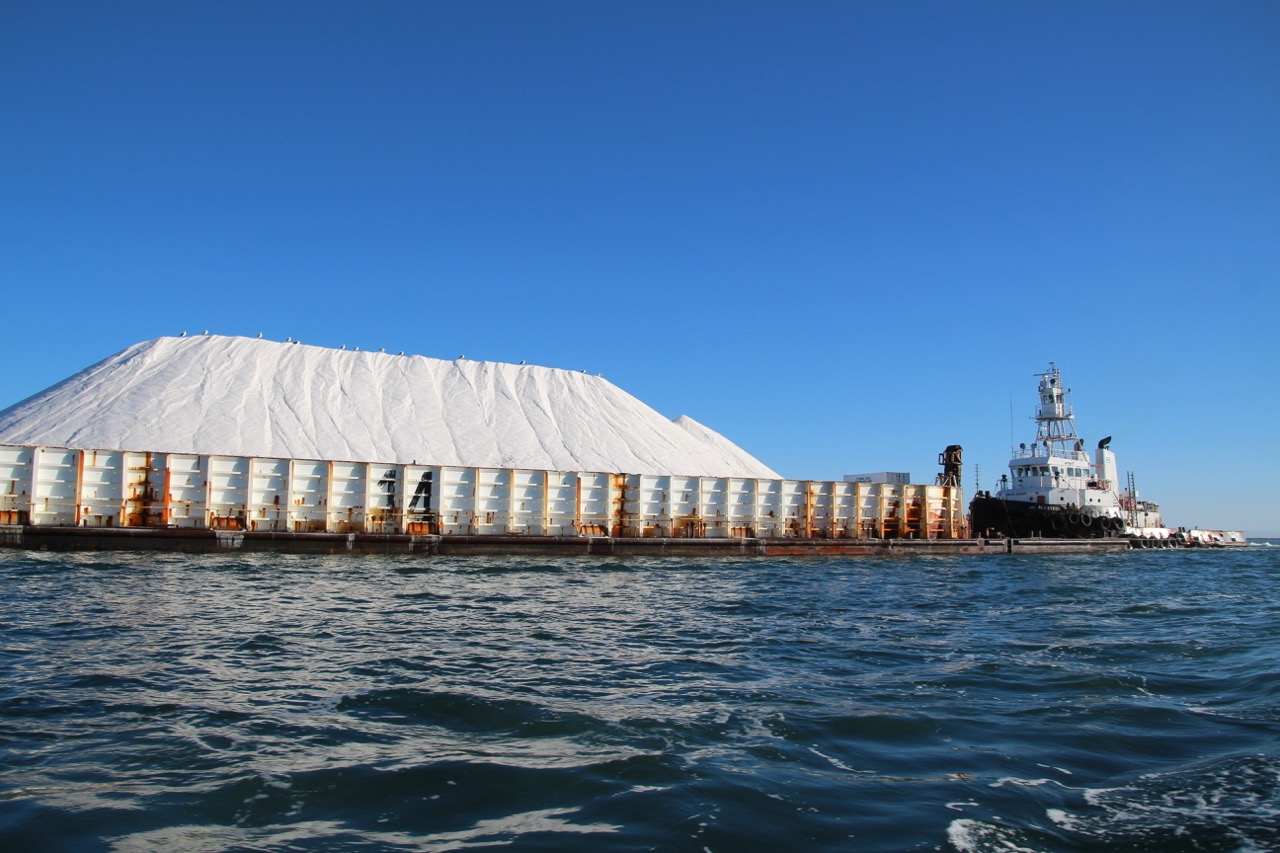From the salt that keeps winter roads safe to the sand and limestone that form the foundation of our infrastructure, minerals are critical to American industry and day to day life as a whole. Moving these materials efficiently and sustainably is essential, and the inland waterway system remains the most capable and cost-effective method for doing so. Every year, millions of tons of salt, silica, and aggregates travel by barge from the Gulf Coast to the Great Lakes, ensuring that industries and communities stay supplied year-round.
Efficiency and Environmental Advantages of Barge Transport
Bulk minerals like salt, sand, and limestone are particularly well suited for barge transportation. Dense, non-perishable, and shipped in massive quantities, these materials benefit from the scale that barges provide. A single covered barge can move more than 1,500 tons of salt, the equivalent of about 60 truckloads, dramatically improving efficiency while easing pressure on congested highways and rail networks.
This scale translates directly into cost savings. On a per ton-mile basis, barges are the most economical mode of transport in the United States. They can move freight nearly 600 miles on a single gallon of fuel, a level of efficiency that neither trucks nor trains can match. For commodities with low value-to-weight ratios, like industrial salt or crushed stone, that fuel economy makes a measurable difference in delivered cost.
The environmental benefits are equally significant. Barges emit far fewer greenhouse gases per ton-mile compared to other modes of freight transportation, supporting shippers’ sustainability goals and helping reduce overall carbon footprints. Covered barges also prevent dust and particulate matter from entering the air and shield cargo from moisture, protecting both product quality and surrounding ecosystems.
Because many mines, quarries, and chemical plants are strategically located along navigable waterways, barge transport minimizes the need for intermediate handling or long overland hauls. Fewer transfers mean less fuel consumption, reduced spillage risk, and lower overall emissions. The result is a supply chain that is not only more efficient and cost-effective but also cleaner and safer for both workers and the environment.
Market Dynamics and Seasonality
The movement of minerals by barge follows a steady but seasonal rhythm shaped by weather and construction cycles. Each winter, demand for deicing salt surges as cities and states prepare for snow and ice. Barge operators move vast quantities of rock salt from Gulf Coast mines and Great Lakes storage terminals to municipalities across the Midwest and Northeast, building up stockpiles before the coldest months.
As temperatures warm, attention shifts toward construction materials like sand, gravel, and limestone. These minerals flow by barge to feed concrete plants, road projects, and infrastructure development throughout the spring and summer. Meanwhile, industrial salts used in chemical manufacturing, water conditioning, and food processing provide a stable, year-round base of cargo, ensuring that barge fleets remain active even outside of peak seasonal windows.
This interplay between seasonal surges and steady industrial demand allows the barge industry to maintain balance and efficiency, with operators adjusting fleet capacity, optimizing terminal operations, and aligning shipment schedules with shifting market needs.
Regional Highlights
America’s salt and mineral supply chains depend heavily on several key inland waterway regions. Along the Gulf Coast, the dense cluster of chemical and petrochemical facilities relies on a steady flow of salt and minerals delivered by barge from nearby production sites. This region’s close integration between waterways and industry makes it a natural hub for both domestic distribution and export.
Farther north, the Great Lakes and Ohio River systems play a pivotal role in supplying road salt to municipalities and delivering limestone and aggregates to construction markets. Barges moving upriver often return downstream carrying different bulk commodities, creating highly efficient two-way trade routes. On the Mississippi River system, the story is similar. Barges transport sand, gravel, gypsum, and phosphates that support infrastructure, agriculture, and energy production across the central United States.
Together, these waterways form a connected network that supports the country’s mineral logistics; a system that continues to prove its resilience and adaptability year after year.
Operational Innovations
As demand for these essential minerals grows, barge operators are increasingly investing in technology and equipment to enhance safety, visibility, and efficiency. Real-time tracking platforms now allow shippers to monitor mineral shipments from origin to destination, offering greater transparency and predictability. Automated loading systems using specialized conveyors and hoppers streamline the transfer of abrasive materials, reducing both labor costs and exposure to dust.
Operators are also turning to predictive maintenance tools to track the wear and tear on vessel components, extending the lifespan of fleets and reducing downtime. Weather-routing technologies add another layer of optimization by allowing operators to plan around storm systems, flooding, or ice conditions, helping ensure timely deliveries even during challenging seasons.
These innovations reflect a broader trend toward digital transformation across the inland maritime industry, with bulk mineral transportation serving as a prime example of how data-driven operations can increase reliability and reduce costs.
Conclusion
Salt and mineral transport may not make headlines, but it forms the literal foundation of modern life. From the road salt that keeps drivers safe in winter to the sand, gravel, and limestone that build the nation’s infrastructure, these commodities sustain the industries and communities that keep America moving. Barge transportation remains the most efficient, sustainable, and resilient way to move these vital materials. As infrastructure investment, climate adaptation, and industrial growth drive new demand, the inland waterway system will continue to serve as a critical link in America’s mineral supply chain.
OpenTug makes it easy to move salt, sand, and aggregates by barge by connecting shippers and operators through one streamlined platform. Manage voyages, optimize routes, and keep your supply chain flowing efficiently. Get started here.

.png)